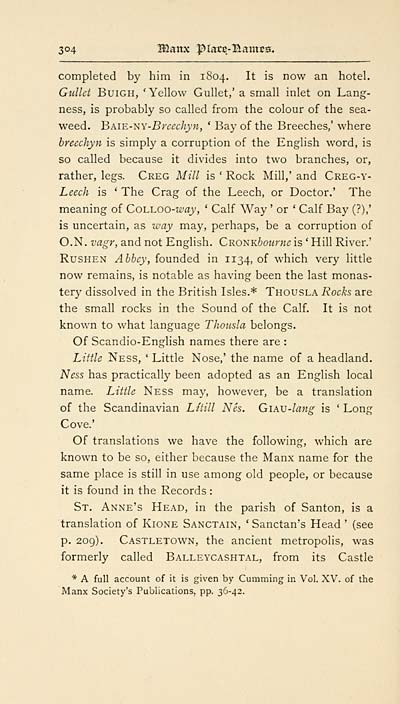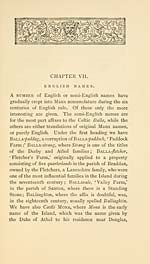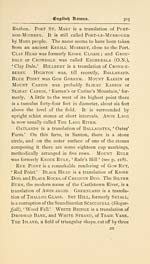Download files
Complete book:
Individual page:
Thumbnail gallery: Grid view | List view

304 Manx |>Iat^-l!lamE0.
completed by him in 1804. It is now an hotel.
Gullet BuiGH, 'Yellow Gullet,' a small inlet on Lang-
ness, is probably so called from the colour of the sea-
weed. BAiK-tiY-Brecchyn, * Bay of the Breeches,' where
hreechyn is simply a corruption of the English word, is
so called because it divides into two branches, or,
rather, legs. Creg Mill is ' Rock Mill,' and Creg-y-
Leech is ' The Crag of the Leech, or Doctor.' The
meaning of Co'L'LOO-way, ' Calf Way ' or * Calf Bay (?),'
is uncertain, as way may, perhaps, be a corruption of
O.N. vagr, and not English. CRONKbourne is ' Hill River.'
RusHEN Abbey, founded in 1134, of which very little
now remains, is notable as having been the last monas-
tery dissolved in the British Isles.* Thousla Rocks are
the small rocks in the Sound of the Calf. It is not
known to what language Thousla belongs.
Of Scandio-English names there are :
Little Ness, ' Little Nose,' the name of a headland.
Ness has practically been adopted as an English local
name. Little Ness may, however, be a translation
of the Scandinavian Lttill Nes. GiAV-lang is ' Long
Cove.'
Of translations we have the following, which are
known to be so, either because the Manx name for the
same place is still in use among old people, or because
it is found in the Records :
St. Anne's Head, in the parish of Santon, is a
translation of Kione Sanctain, ' Sanctan's Head ' (see
p. 2og). Castletown, the ancient metropolis, was
formerly called Balleycashtal, from its Castle
* A full account of it is given by Gumming in Vol. XV. of the
Manx Society's Publications, pp. 36-42.
completed by him in 1804. It is now an hotel.
Gullet BuiGH, 'Yellow Gullet,' a small inlet on Lang-
ness, is probably so called from the colour of the sea-
weed. BAiK-tiY-Brecchyn, * Bay of the Breeches,' where
hreechyn is simply a corruption of the English word, is
so called because it divides into two branches, or,
rather, legs. Creg Mill is ' Rock Mill,' and Creg-y-
Leech is ' The Crag of the Leech, or Doctor.' The
meaning of Co'L'LOO-way, ' Calf Way ' or * Calf Bay (?),'
is uncertain, as way may, perhaps, be a corruption of
O.N. vagr, and not English. CRONKbourne is ' Hill River.'
RusHEN Abbey, founded in 1134, of which very little
now remains, is notable as having been the last monas-
tery dissolved in the British Isles.* Thousla Rocks are
the small rocks in the Sound of the Calf. It is not
known to what language Thousla belongs.
Of Scandio-English names there are :
Little Ness, ' Little Nose,' the name of a headland.
Ness has practically been adopted as an English local
name. Little Ness may, however, be a translation
of the Scandinavian Lttill Nes. GiAV-lang is ' Long
Cove.'
Of translations we have the following, which are
known to be so, either because the Manx name for the
same place is still in use among old people, or because
it is found in the Records :
St. Anne's Head, in the parish of Santon, is a
translation of Kione Sanctain, ' Sanctan's Head ' (see
p. 2og). Castletown, the ancient metropolis, was
formerly called Balleycashtal, from its Castle
* A full account of it is given by Gumming in Vol. XV. of the
Manx Society's Publications, pp. 36-42.
Set display mode to: Large image | Transcription
Images and transcriptions on this page, including medium image downloads, may be used under the Creative Commons Attribution 4.0 International Licence unless otherwise stated. ![]()
| Early Gaelic Book Collections > Blair Collection > Surnames & place-names of the Isle of Man > (322) |
|---|
| Permanent URL | https://digital.nls.uk/82103512 |
|---|
| Description | A selection of books from a collection of more than 500 titles, mostly on religious and literary topics. Also includes some material dealing with other Celtic languages and societies. Collection created towards the end of the 19th century by Lady Evelyn Stewart Murray. |
|---|
| Description | Selected items from five 'Special and Named Printed Collections'. Includes books in Gaelic and other Celtic languages, works about the Gaels, their languages, literature, culture and history. |
|---|

